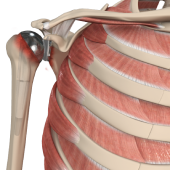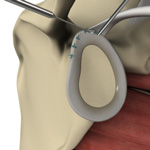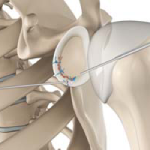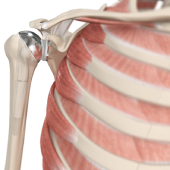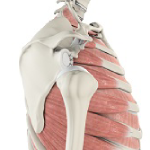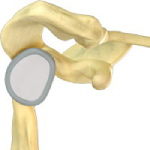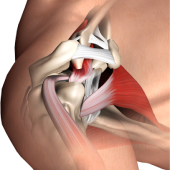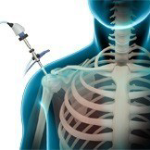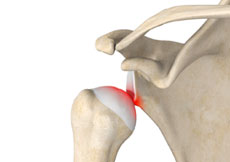Shoulder Procedures
- Anatomy
- Conditions
- Procedures
Revision Shoulder Replacement
Total shoulder replacement usually has good results, but a revision surgery may occasionally be necessary due to persistent pain, infection, stiffness, weakness, instability, hardware loosening, malposition or fracture.
Reverse Shoulder Replacement
Conventional surgical methods such as total shoulder joint replacement have been shown to be significantly ineffective in the treatment of rotator cuff arthropathy. Reverse total shoulder replacement is an advanced surgical technique specifically designed for rotator cuff tear arthropathy, a condition where you suffer from both shoulder arthritis and a rotator cuff tear.
SLAP Repair
A superior labrum anterior and posterior tear or SLAP tear is an injury to the labrum. This injury may also involve the biceps tendon, which is attached to the top part of the labrum. The injury occurs from repeated use of the shoulder while throwing or a fall onto the shoulder.
Arthroscopic Bankart Repair
The labrum can sometimes tear during a shoulder injury. A specific type of labral tear that occurs when the shoulder dislocates is called a Bankart tear. This is a tear to a part of the labrum called the inferior glenohumeral ligament and is common in the young who sustain a dislocation of the shoulder. A Bankart tear makes the shoulder prone to repeat dislocation in patients under 30 years of age.
Shoulder Joint Replacement
Total shoulder replacement surgery is performed to relieve these symptoms. In this surgery, the damaged articulating parts of the shoulder joint are removed and replaced with artificial prostheses. Replacement of both the humeral head and the socket is called a total shoulder replacement.
Shoulder Labrum Reconstruction
Traumatic injury to the shoulder or overuse of the shoulder by excessive throwing or weightlifting can cause a labral tear. In addition, the aging process may weaken the labrum, leading to injury secondary to wear and tear.
Latarjet Procedure
The shoulder joint provides a wide range of movement to the upper extremity, but overuse or trauma can cause instability to the joint. The Latarjet procedure is a surgical procedure performed to treat shoulder instability by relocating a piece of bone with an attached tendon to the shoulder joint.
Shoulder Stabilization
When conservative treatment options such as medications, rest and ice application fail to relieve shoulder instability, your surgeon may recommend shoulder stabilization surgery.
Subacromial Decompression
Subacromial decompression is a surgical procedure performed for the treatment of a condition called shoulder impingement. In shoulder impingement, the degree of space between the rotator cuff tendon and shoulder blade is decreased due to irritation and swelling of the bursa or due to development of bone spurs. Subacromial decompression opens this space by removing the bony spurs or any inflamed or swollen bursa enabling free shoulder movement.
Shoulder Arthroscopy
Arthroscopy is a minimally invasive diagnostic and surgical procedure performed for joint problems. Shoulder arthroscopy is performed using a pencil-sized instrument called an arthroscope. The arthroscope consists of a light system and camera that projects images of the surgical site onto a computer screen for your surgeon to clearly view. Arthroscopy is used to treat disease conditions and injuries involving the bones, cartilage, tendons, ligaments, and muscles of the shoulder joint.
Distal Clavicle Excision
Distal clavicle excision is a procedure which involves removal of the outer end of the clavicle (collarbone) to treat shoulder pain and disability due to arthritis or impingement.
Capsular Release
A capsular release of the shoulder is surgery performed to release a tight and stiff shoulder capsule, a condition called frozen shoulder or adhesive capsulitis. The procedure is usually performed arthroscopically through keyhole-size incisions.
Proximal Biceps Tenodesis
Proximal biceps tenodesis is the surgical reattachment of a torn proximal biceps tendon, which connects the upper part of your biceps muscle to the shoulder.
Failed Shoulder Surgery
Failed shoulder surgery is a surgery that did not meet expectations and resulted in recurring pain or other unwanted symptoms. All surgeries are associated with risks, some have a higher risk than others. The most commonly reported failed shoulder surgeries include rotator cuff repairs and shoulder stabilization for shoulder instability.
Bicep Tendon Rupture at Shoulder
Overuse and injury can cause fraying of the biceps tendon and eventual rupture. A biceps tendon rupture can either be partial, where it does not completely tear the tendon or complete, where the tendon completely splits in two and is torn away from the bone.
Pectoralis Major Tears/Repairs
The pectoralis muscle is a large fan-shaped muscle comprised of the pectoralis major and pectoralis minor muscles that stretch from the armpit to the collarbone and down across the lower chest region on both sides of the chest. The two sides of the chest connect at the breastbone or sternum. The pectoralis major is a powerful muscle that aids in rotating the arm inward and move it closer to the body. The pectoralis muscles connect the chest wall with the humerus (upper arm bone) and shoulder. The pectoralis major moves each shoulder joint in four distinct directions and also keeps the arms attached to the body.
Mumford Distal Clavicle Excision
A Mumford distal clavicle excision is a surgical procedure which involves excision or resection of the outer (distal) end of the clavicle, also called the collar bone.
ORIF of the Clavicle Fractures
A clavicle fracture refers to a broken collarbone and is a common injury associated with contact sports such as football and martial arts, as well as impact sports such as motor racing. A direct blow over the shoulder, a fall on an outstretched arm, or a motor vehicle accident may also cause the clavicle bone to break. Most clavicle fractures occur in the shaft or middle portion of the bone. Clavicle fractures are quite common and occur in individuals of all ages.
Acromioclavicular Joint (AC) Joint Reconstruction
The acromioclavicular (AC) joint is one of the joints present within your shoulder. It is formed between a bony projection at the top of the shoulder blade (acromion) and the outer end of the clavicle (collarbone). The joint is enclosed by a capsule and supported by ligaments.
Others
Am I a Candidate for Shoulder Replacement?
Shoulder replacement is a surgical procedure where the damaged parts of your shoulder are removed and replaced with artificial parts known as prostheses. The shoulder is a ball-and-socket joint made up of three bones; the humerus (upper arm bone), scapula (shoulder blade), and clavicle (collarbone). The ball at the top of the upper arm bone fits neatly into a socket, called the glenoid, which is part of the shoulder blade. The surfaces of the bones where they touch are surrounded with articular cartilage, a smooth substance that protects the bones and allows them to move smoothly against each other. If your cartilage is damaged by wear and tear, injury, or arthritis, it can make your shoulder joint stiff and painful necessitating shoulder replacement.
Shoulder Fracture Care
A break in the bone that makes up the shoulder joint is called a shoulder fracture. The clavicle (collarbone) and end of the humerus (upper arm bone) closest to the shoulder are the bones that usually are fractured. The scapula, or shoulder blade, is not easily fractured because of its protective cover of surrounding muscles and chest tissue.
Am I a Candidate for Shoulder Surgery?
If the cause of your pain is not determined through history and examination, your doctor may recommend shoulder arthroscopy to view the inside of your joint. Depending on your condition nonsurgical treatment options may be recommended before considering surgery. Sometimes a definite problem is identified that is best treated by surgery. Several shoulder abnormalities can be treated with tiny instruments during arthroscopy without the need for another procedure.
Labral Repair/Shoulder Stabilization
Labrum repair is a surgical technique recommended for treating labrum tear. Labrum is a triangular, fibrous, rigid cartilage structure lining the ball-and-socket joint of the shoulder. It provides cushioning support to these two joints. It also deepens the socket and helps to stabilize the joint.












